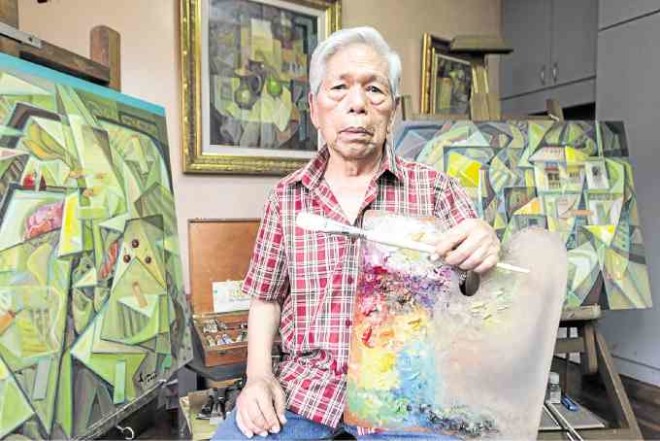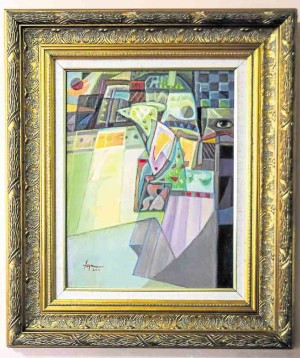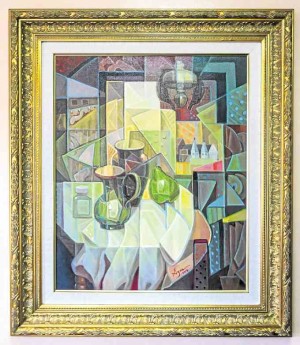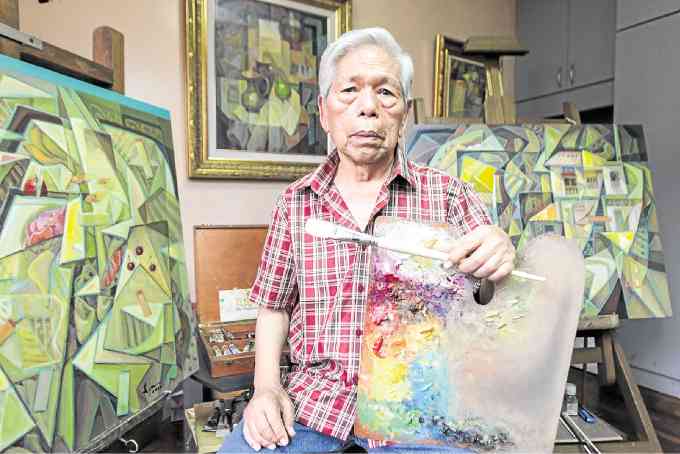
An “old man mad with painting”—that was what the Japanese called Hokusai, one of their greatest artists.
On his deathbed, at age 89, he declared: “If only Heaven will give me just another 10 years… Just another five more years, then I could become a real painter.”
The same undying passion animates Sofronio Ylanan Mendoza, better known by the initials with which he signs his works: Sym.
The Cebu-born painter celebrated his 83rd birthday last March 10 with an exhibit at the Mezzanine of the Makati Shangri-La Hotel, mounted by Hiraya Gallery. (The exhibit runs until March 27.)
Although he has slowed down considerably since his fourth angioplasty, after which his cardiologists decided to install a pacemaker, Sym’s heart still beats only for his art.
“Art still holds a lot of challenges,” he says in Tagalog, which still bears traces of a Cebuano accent despite the artist having lived in Manila since the 1960s, and Vancouver since the 1980s.
“There’s no end to it,” he adds.
High-fidelity
Often, he says, he closes his eyes just before going to sleep and his mind is suddenly filled with abstract shapes, very clear, in high-fidelity. Sometimes the flashes of inspiration come while he’s watching TV. But when he attempts to capture them on paper the next day, he always ends up with something quite different.
Perfect expression is always elusive and just beyond his grasp.
“Lately, in retrospect,” he continues, “I’ve been looking at all I’ve done, and there’s still something lacking. Not wrong, but lacking. I feel that my paintings are lacking in poetic expression—that’s what I want to achieve. I’m still searching for the technique that will allow me to achieve that expression.”
Maybe, in five years or so, he might try sculpture, he says with a smile.
Quiet corner
We are in the artist’s studio in a quiet corner of San Juan, which he shares with his wife Ely. The walls are hung with paintings from various stages of his career, some in the classical realist style which he favored early on, and some in the neo-cubist style which, counter-intuitively, he returned to in 2000.
“Now that my seven children are all grown, I’m free,” he says. “I can work anytime, anywhere, and we’ve decided to spend more time here than in Canada.”
Ely interrupts him momentarily to apply a transdermal patch, a sustained-release heart medication. After a while, Sym becomes more animated, although it’s hard to tell whether it’s the medication kicking in, or talking about art, that’s responsible.
Sym ushers us into his sunlit atelier, where two easels display recent canvases. More paintings lean against the walls, all in the style that he calls “new millennium cubism.”
At the height of his powers, he says, he could finish a four-by-six-foot painting in a mere four or five hours. Now, he says a bit ruefully, it sometimes takes him months to finish just one canvas.

It’s not just age and infirmity slowing him down, he hastens to add. His new works are much more complex and subtle and difficult to execute. He shows us sketchbooks full of preliminary drawings, sometimes indicating directional lines or with notations for colors.
His style of cubism, he says, retains an element of realism. Indeed, he still favors the classic themes: nudes, still lives, landscapes, but fractalized in prismatic colors and shapes, suggesting rhythmic movement and directionality.
“I try to incorporate shapes and harmony of colors,” he adds. “It takes science and knowledge, not just pure intuition. With abstract art, you can go by pure intuition, but with this, it takes planning. It’s like architecture. It’s easy to build a barung-barong, but a 50-story building—you need a plan.”
There was a time, when he was younger, when he would paint all day and into the wee hours of the morning.
“It’s as if you’re flying,” says Sym. “When you’re engrossed in painting, you lose track of time.”
These days, he says, he starts at 2 or 3 in the afternoon, and makes it a point to knock off at midnight or 1 a.m.
But not a day goes by when he doesn’t pick up his brushes and pigments.
“I’m a prisoner of my work,” he says.
Every so often, Ely will ask him to go out so he can get some new clothes, but Sym would rather stay home and paint.
“Doing anything you’re passionate about keeps you young,” he swears. “Every cell in your body starts to move.”
Love of comics
How Sym got to this point in his life bears retelling.
Born in the small town of Putat Bagong Bayan in Cebu in 1934, an incipient love of drawing was nurtured by a love of comics, leading to the dream of one day becoming an illustrator. In particular, he admired the mastery of line in the work of Francisco Coching, the premier illustrator during the golden age of Filipino komiks.
Eventually, Sym managed to study under painter Martino Abellana, a protégé of Fernando Amorsolo, who emulated the latter’s style of classicism, so much so that he later labored under the mantle “the Amorsolo of the South.”
“He was my first mentor,” recalls Sym. “That’s why I know traditional art—because of him.”

In his late 20s, however, he decided to start a new life, and came to Manila with only five pesos to his name. Even in 1961, five pesos didn’t go very far, and after a stint sleeping in Luneta park, he found his way to A. Mabini Street in Ermita, then the center of “commercial” art.
There he managed to eke out a bare living churning out decorative paintings for tourists and locals.
Formal studies
As luck would have it, one of his colleagues in Mabini introduced him to his father, a budding entrepreneur from Bulacan named Cipriano Villanueva. Spotting Sym’s obvious talent, the latter generously decided to put him through formal art studies at the University of Sto. Tomas, even though he was already past 30.
“At that time, modern art was on a pedestal,” he recalls.
Vicente Manansala, H.R. Ocampo and the rest of the so-called “13 Moderns” had made their artistic and commercial breakthroughs and were considered the leading lights of contemporary Philippine art. Suddenly, Sym’s Amorsolo-esque works seemed very old hat indeed.
“When I entered UST, I was still doing traditional art,” he says. “My professors told me that it wouldn’t do, I would fail. Modern art was the standard being taught all over the world. Amorsolo was over, Manansala was the new hero.”
Sym turned his brush to painting in the neo-cubist manner made popular by the Moderns, which won his professors’ approval and even a few art competitions after he transferred to the University of the East.
By this time, he had married his patron’s 16-year-old daughter Elena, started a family, and attracted a coterie of like-minded artists who would later be called the Dimasalang Group (after the street in Sampaloc where Sym kept his studio). This included E. A. “Abe” Cruz, Romulo Galicano, Ibarra de la Rosa and Andres Cristobal Cruz.
Contemporary realism
With the Dimasalang Group, Sym abandoned his cubist experiments and settled on a more contemporary form of realism. He soon became one of the country’s better-known painters, receiving both critical and commercial acclaim.
In his 1987 essay “The Quiet Revolt of Sofronio Y. Mendoza,” Ambeth Ocampo wrote: “The artistic climate in 1968 at the time Sym founded the Dimasalang group was revivalist in the sense that a few decades earlier the ‘Moderns’ Victorio Edades, Hernando Ocampo and others had gone against the blind adoration which reduced the genre of Fernando Amorsolo into Mabini Art… It was artistic suicide to be a ‘conservative’ (meaning representational) painter at this time but Sym felt that he was part of a great tradition which had not yet reached the peak of its evolution. He looked up to old Philippine masters: Juan Luna, Felix Resurreccion Hidalgo, Fabian de la Rosa, Fernando Amorsolo and of course his mentor Martino Abellana who made him realize that he was still part of that development of Philippine painting which had not yet achieved full flowering… Sym made representative art, denigrated by the critics as almost photographic or old-fashioned, reputable again. Sym produced a quiet revolt, a renaissance if you want to call it that, in Philippines painting with his sunlight canvases and engaging interiors.”
Somewhat presciently, Ocampo ended by asking the question: “Granting that he does reach the zenith of his craft and artistic development the ticklish question is: What movement will he start next? The art scene today is representational, former abstract artists have now returned to the basics, so to speak, so what will Sym do next? A shift to the modern?”
Point of pride
When the economic situation in the Philippines turned glum after a decade of Martial Law, Sym had decided to immigrate to Canada in 1981. He settled his wife and seven children in Vancouver, where he made a living giving painting lessons.
It is still a point of pride that he has managed to support his family and put his children through college through his painting alone.
Ever prolific, Sym continued to exhibit his works at least once a year in Manila. He even found time to organize two more generations of the Dimasalang Group: one in Manila and another in Vancouver.
By 2000, however, he was feeling stale.
“I was at the highest point of my realism,” he says. “I was selling all my work, but I told my wife I wasn’t happy with it—there was no challenge left, I had done all I wanted to do with it.”
At this point, he decided to return to his earlier triumphs as an art student, when his experiments in neo-cubism were winning art competitions.
“I felt young again when I returned to cubism,” he says. “Every new work was a challenge. I felt like a new person. There is a transformation, because you have to change the way you see, the way you think.”
He decided to call his new style “new millennium cubism,” something of an oxymoron since cubism was a style that reached its peak in the 1920s and all but died out by 1930.
Seeming dilemma
Critic Cid Reyes acknowledged Sym’s seeming dilemma in his essay “A Sym Card to Cubism”: “For these works to emerge in the 21st century even compounds the problem of assessing his works… To be sure, Sym had taken the grave risk of being denounced as derriere-garde as opposed to being avant-garde.”
But he goes on to add: “Undoubtedly, Sym’s works are all visually intelligible and guided by purely formal concerns… An expert in building up his forms, Sym revels in the use of geometry which defines each of the paintings in the insistent and progressive multiplicity of squares and rectangles, circles (dots) and triangles, all conjoined in a dazzling and dynamic design. There is all assurance that Sym exercised perfect control in manipulating the pictorial space reaching into a deep recession.”
“Sym, grounded in the radiant light of his country, harmoniously blends the brilliant colors of the spectrum, almost ritualistically blending alizarin reds with peaches and oranges, sky blues with chartreuse and viridian, lemon and chrome yellows shifting with purples and pinks and magentas. Elation in colors will never leave a Filipino Cubist.”
Freedom of expression
As for Sym, he no longer feels the need to justify himself, or his art.
“The bottom line in art is total freedom of expression,” he says. “As an artist, you have the license to express yourself the way you want, even if it means reviving the past. It’s all up to you. As long as what you paint is different from the rest. You have to have a signature, otherwise it’s as if you’ve remained a student all your life.”
His friend, the writer Alfredo “Ding” Roces, paid him the best compliment when, after viewing Sym’s recent paintings, he reportedly said: “These are the works of a young man.”













































